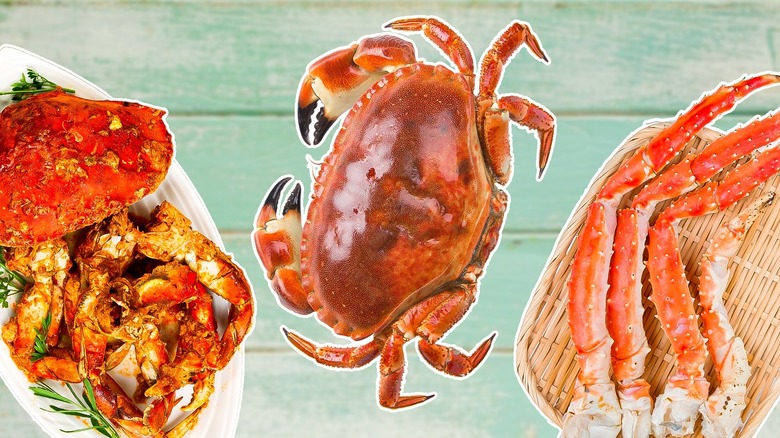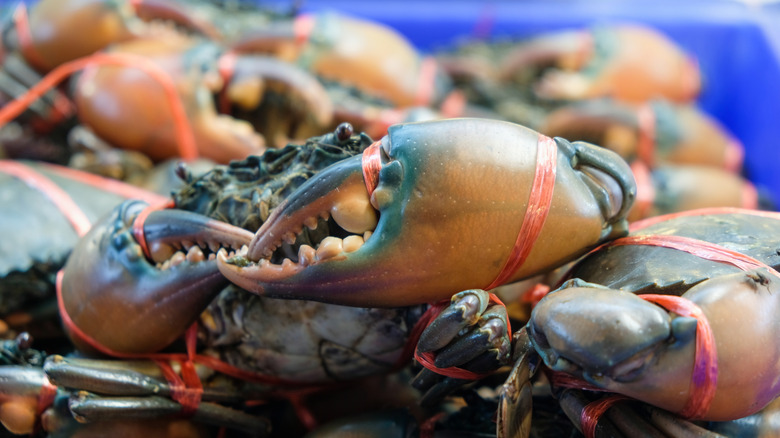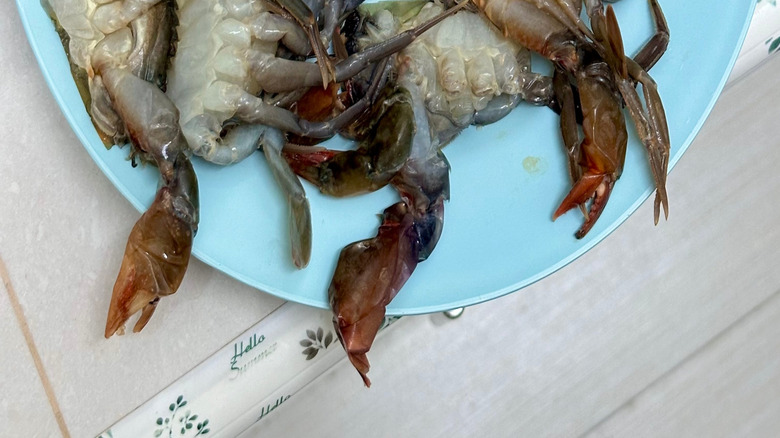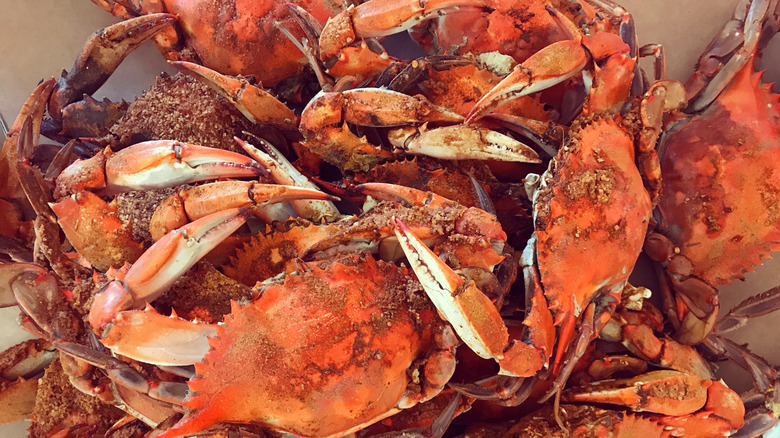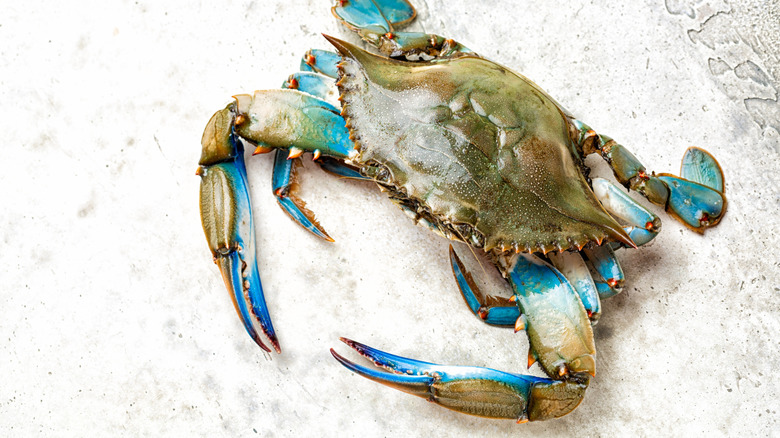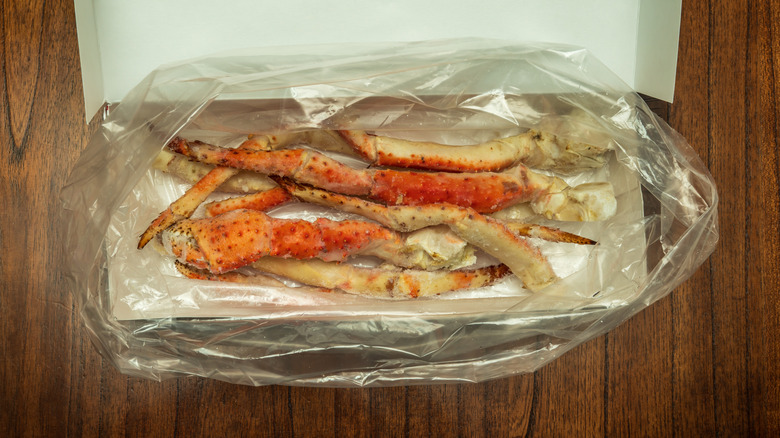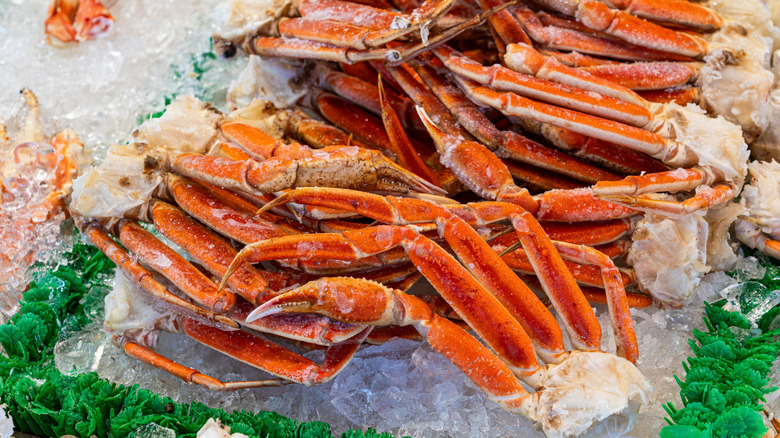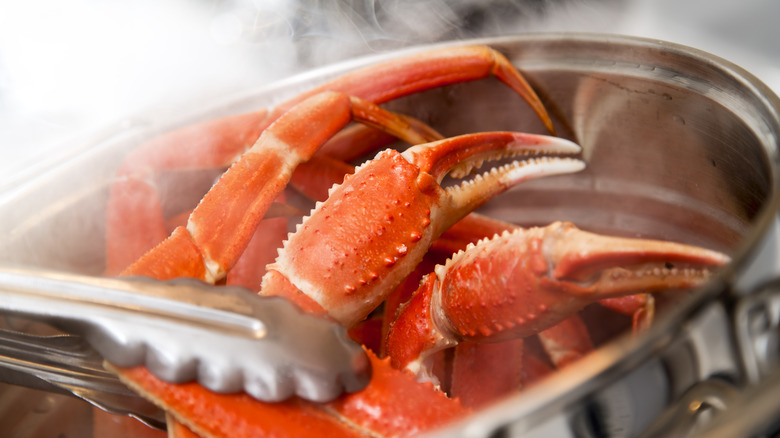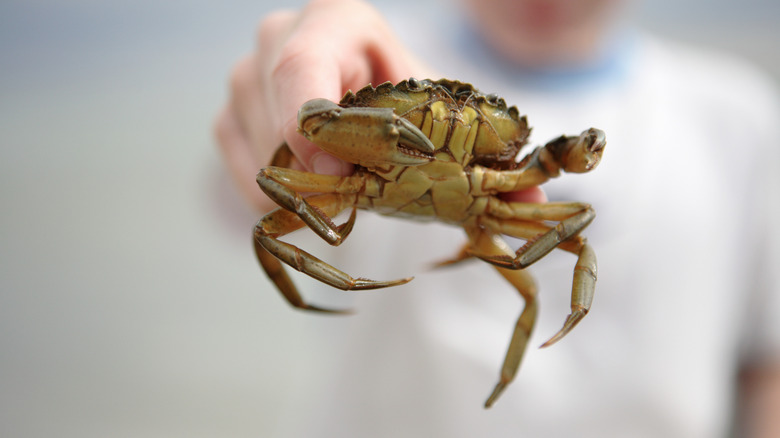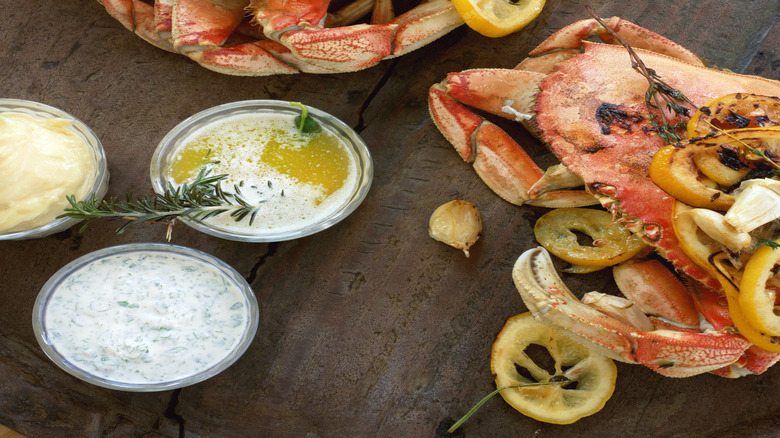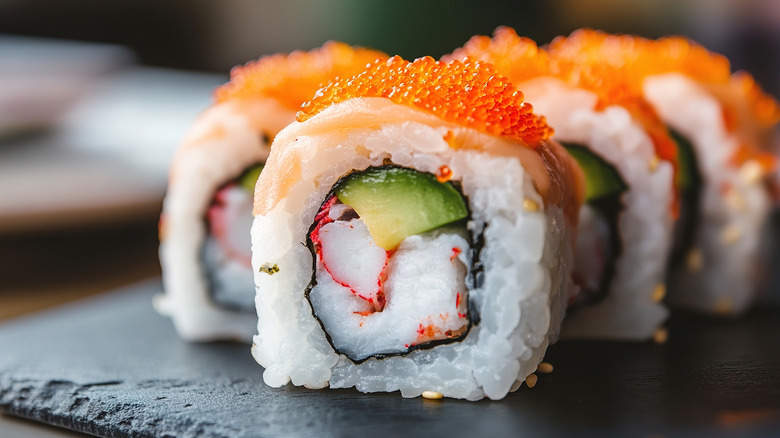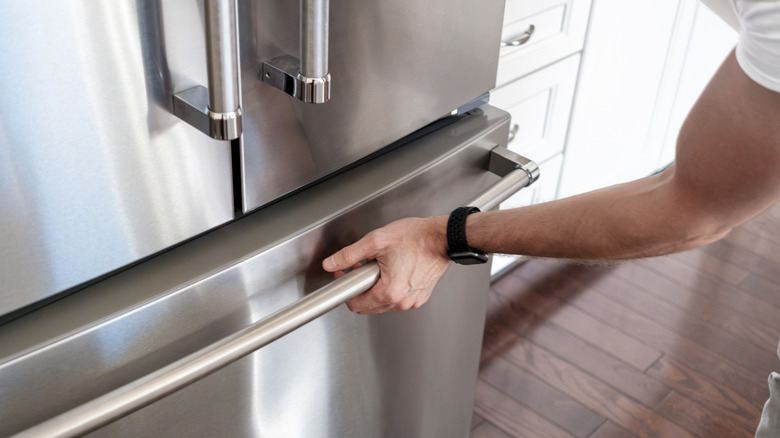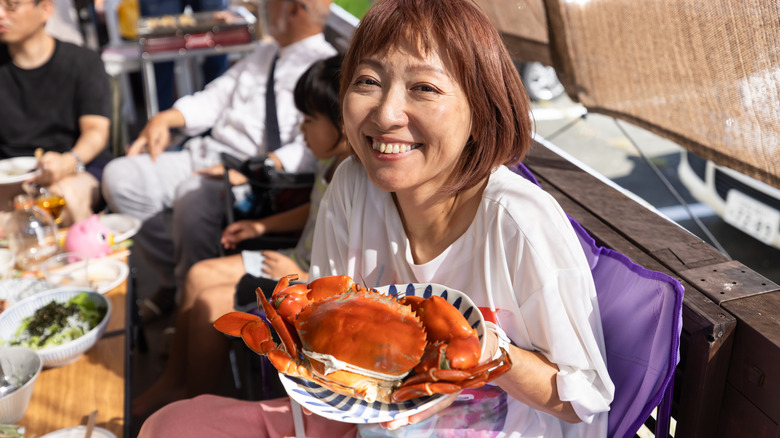Everything You Need To Know About Buying, Preparing, And Cooking Crabs
Most people agree that crab is delicious. So why aren't more people eating it at home? Aside from the fact that they look a bit like giant spiders (which is, of course, upsetting), crab can be intimidating to cook and clean. For that reason, most people enjoy it when they're out and about in the world, but feel it's inaccessible in the home kitchen, which couldn't be further from the truth.
Crab is actually a relatively easy food to buy, prep, and cook. While it's not always the cheapest option, you can save big if you go crabbing yourself or buy it somewhere close to the water. Today's burgeoning pasteurized and frozen options make it very easy to get crab, even if you've yet to set eyes on the sea yourself. Point being? You got this.
It's always good to get the help of experts, though, which is why Chowhound reached out to several expert seafoodies to get their take on everything crab-related. What better way to celebrate October's National Pescatarian Month than by learning to buy and make it yourself? Go ahead, dive on in.
The main types of culinary crab
There are many types of crab appropriate for cooking: Mud, Dungeness, snow, blue, king, stone, Jonah, and many more around the world. And Maryland blue crabs are special because they come from cold water, which makes them extra buttery-tasting. Although there are thousands of species of crabs (about 6,500 according to some sources), less than a dozen of them are commonly eaten. This is for reasons of accessibility, size, and preference. Some culinary crabs are only to be found in certain places, such as hairy crabs. These are said to be delicious and are enjoyed throughout China and Singapore. However, they're considered a dangerous invasive pest in North America and Europe, so you can't import them. The main species listed above are the ones you can get in the United States.
So which should you start with? "Dungeness crab is ideal for beginners," says Xiaojun Guo, the culinary brains behind The Cantonese Cook. "It's widely available, easy to clean, and its sweet, delicate flavor pairs well with simple preparations. Plus, its larger size makes it easier to extract the meat compared to smaller varieties."
Some home chefs may also wonder about the difference between white and brown crab meat. It's simple: Brown comes from inside the body cavity and includes organs and glands, while white meat comes from the legs and claws and lacks the depth of flavor and oiliness that comes from those other parts. You can eat both plain or incorporate brown into a sauce or otherwise disguise it.
What is softshell crab?
Although many people assume soft-shell is a species of crab, it is actually a stage in the crab's normal lifecycle. A crab is "soft-shell" if it has recently shed its hard outer shell, known as molting, and is in the process of forming another. At this stage, the outer shell is edible, which makes preparation easier and is a novel way to eat the same food. Soft-shell crabs are not in season during the winter months but are accessible from spring through fall along the Gulf and East Coasts.
Softshell crab has the same sweet, briny flavor and tender meat that regular hardshell crab does. The only difference is that there's some extra crunch, so it's really up to you if you enjoy the added texture. Note that in some places, it is illegal to catch softshell crabs, so make sure you're not contributing to unethical fishing practices by only eating it in season in designated areas.
Is pre-cooked crab as good as fresh?
Sometimes sourcing and prepping a whole crab (or, depending on how many people you're serving, several whole crabs) is kind of a big ask. If that happens, just take the easy route and buy pre-cooked crab, which is an excellent option if you're short on time. Although fresh crab does have a more vibrant taste and firmer texture, Xiaojun Guo says, "Pre-cooked crab is convenient and retains much of the flavor. When buying pre-cooked, check that it has been refrigerated properly, and avoid any with a fishy or sour smell, which indicates spoilage."
It's also an easy route for beginners just learning to cook with crab, says Anthony D'Angelo, 5th generation co-owner of Samuels Seafood Company. He recommends you buy "pre-cooked crab meat like Blu™ Crab, which comes in 1-pound containers, allowing you to enjoy it directly or mix it with ingredients like mayo and breadcrumbs for dishes like crabcakes. Simply bake or fry for a quick meal."
D'Angelo notes, however, that you'll want to reserve this option "for dishes where the crab isn't the star ingredient but adds flavor." In fact, "For recipes like salads or dips, pre-cooked can be preferable. However, for dishes where the crab's freshness is crucial, like steamed Blue Crab, live crabs are ideal." If you're not certain, he says, just ask your fishmonger what will work best.
How to select live crab
If you're up for the challenge, then cooking live crab will give you the purest experience of crab flavor. Many people enjoy the meat on its own, while others enjoy it with simple flavorings like lemon or butter (and don't worry, we'll get to that). If you're going to go the live route, though, you should make sure you're getting the best possible version.
"Always look for crabs that are lively and active, as this indicates freshness," says Xiaojun Guo. "A fresh crab should feel heavy for its size; that means it's full of meat. Avoid crabs with a strong ammonia-like odor, as this is a sign they're past their prime." Although "live" crabs are still safe 10-12 hours or so after they die, according to Anthony D'Angelo, you ideally want a crab that is still moving for the best flavor. When selecting them from the tank, choose the ones you want and let the fishmonger know rather than having them pick for you.
Choosing the best pre-cooked crab
Not quite ready for a live one? No worries. There are plenty of amazing pre-cooked crab options on the market these days. In fact, says Stephanie Harris-Uyidi of the popular seafood blog The Posh Pescetarian, "Wild precooked crab can be a tastier, better-quality option than the live crab that you'll find in some tanks. This is because most crab boats cook and flash-freeze their catch right on the vessel or at least hours after harvesting. This ensures freshness and results in plump flavorful crab."
There are many types of pre-cooked crab. There's the fresh stuff, which has been cooked and picked, and this gives you a superior flavor than canned or pasteurized, says Anthony D'Angelo, but there's a greater danger of shell fragments, so watch out. Then there's the pasteurized version, which according to D'Angelo has a longer shelf life in the fridge but won't freeze well. You can also buy whole cooked crabs at the meat counter, ready to crack into.
Whatever option you choose, make sure it's fresh enough to maintain flavor and keep you safe. If you're buying it at the meat counter, check for crisp, bright shells and a slightly sweet smell. Avoid anything with a sour, fishy, or off aroma. If you're buying in tubs, check the date on the container. Remember that fresh crab has sometimes been flash-frozen, so be on the lookout for dull or off-color patches or freezer burn.
Choosing the best frozen crab
Crab comes in lots of options in the freezer section. Snow, king, and Dungeness crabs are all good choices for frozen legs that require only reheating, Anthony D'Angelo says. You can also buy picked frozen crab and steam, stew, or oven roast it, says Stephanie Harris-Uyidi. Defrost it under refrigeration for safety's sake and prepare it within 24 hours to maintain freshness, she adds.
Make sure, when you're buying frozen crab, that you check the expiration date. Look for meat that's firm, white, and evenly colored, without any signs of freezer burn. The package should be tightly sealed. Where possible, you should also buy seafood that is sustainably sourced — you can do a quick Google search on most seafood to find out about its fishery practices. As a side note, if you only need a small bit of crab for a dish (say, a sushi roll), you could try buying and cooking imitation crab instead, which can be cheaper.
If you're not sure where to get started with frozen crab, you can always ask the fishmonger at your local grocery store. Although the crab on display will be fresh, they'll know how to point you in the right direction in the freezer. In some situations, they may have a better option for your recipe, so it's always worth a chat.
How to cook crabs
Many people get fussed when they think of boiling or steaming crab because there's a lot of terror associated with a) boiling pots of water; b) undercooking or overcooking unfamiliar foods; and c) cooking things alive. Fair enough. But as Jamie Fraser would say, "Dinna fash yersel, Sassenach." Translation: calm down. It's easier than you think, and you'll be steaming crab legs perfectly in no time.
Indeed, steaming is the way to go. While the common way to cook crabs is to boil them in a pot, steaming is the best way to preserve crab's delicate flavor, according to some experts. Bring the water to boil, put them in a pot, and cook them for the length of time specified by their type and body weight, then remove them. Let them cool, and then clean them.
If you're a beginner, says Stephanie Harris-Uyidi, go for Dungeness and king crab legs to start. They're readily available and yield lots of meat, so they're worth the work. It's also a good idea to work with a partner. Putting the crabs in and out of the pot and getting the lid on quickly is important to maintain the correct temperature inside the pot, so it's good to have a buddy to help out.
How to clean crabs
Some people say you should gut crabs before cooking, but most people are uncomfortable with the idea of cutting into a live crab, aka vivisection. For that reason, it is most common to cook the crab first and then clean it. Note that this is separate from cleaning the outside before cooking, which you might want to do if there's lots of mud or dirt on your crabs. Just give them a quick rinse and scrub with a brush to remove the main particles of debris so they don't get into the good stuff.
In general, though, "cleaning" refers to removing the guts and unnecessary parts that you don't want around when eating. These include the gills, mouth, and lungs. To do this, you first cook the crabs and let them cool. Then you remove the legs and claws using a twisting motion. Pull off the apron (the triangle at the base of the shell's underside), then remove the innards by simply pulling them out, before cracking the body in half for serving. You can then serve the crabs right away if everyone wants them hot, or cool them in the fridge if you're eating cold or picking them for a dish.
Easy ways to serve crab
One of the best, or at least most popular, ways to serve crab is simply cooked and cleaned, put on a plate, and accompanied with a few condiments. Some prefer lemon and butter, while others like garlic mayo or Caesar dressing. You can get creative and try more unconventional dipping sauces too, such as avocado wasabi, curry mustard, or brandy mayonnaise. Just set out sauces in ramekins or bowls for people to do their dunking.
Some chefs advise you to simply use the crab's own tomalley or "mustard" for dipping, because it packs a delicious briny punch. This yellow matter, found inside a crab's shell, comes from an organ that essentially functions like the liver. Many people enjoy it, but it can be dangerous since this organ vacuums up toxins. Make sure you know where your crab comes from if you're going to eat this ready-made condiment, but don't make the mistake of just throwing it out without trying it first.
Also, when serving crab, beware of accidentally cooking it twice. "It always breaks my heart a little when I hear people say that they boil whole crab or crab legs to 'cook' them," says Stephanie Harris-Uyidi. "Truth be told, it's totally unnecessary. Ninety-nine percent of the time, the crab you buy at the market is already cooked and just needs to be heated through." So make sure before you go to cook your crab that it's not already good to go for serving, and avoid cooking twice. Pre-cooked crab can be served hot or cold, by the way; it's all up to preference and season.
Delicious crab recipes
There are endless ways to prepare crab. You can fry up soft shell crabs and put them in sushi or sandwiches. "This method requires minimal cleaning and offers an exciting way to eat crab," says Anthony D'Angelo. Crab stir fries are another delicious way to add some brine to an otherwise bland pan of veggies.
If you're feeling Italian, D'Angelo recommends crabs with spaghetti, "An Italian-American dish where Blue Crabs are cooked in a rich tomato sauce with garlic and wine, then served over pasta. The crabs are often eaten separately, seasoned by the sauce, providing a dual dining experience of pasta and crab." In the mood for Asian flavors instead? "I love steaming Dungeness crab with ginger and scallions for a fresh, aromatic dish," Xiaojun Guo says. "Stir-frying crab with salted egg yolk is a Cantonese classic that delivers rich, umami flavor." She also loves to make simple crab congee, or rice porridge.
Rima Kleiner, a nutritionist from Dish on Fish, loves to get creative with her crab dishes. On the list are egg and crab muffins, crab-stuffed acorn squash, and avocado-crab Benedicts. Seriously, who could say no to that? Of course, crab cakes, seafood gumbo, and crab roasts are all wonderful, adds Stephanie Harris-Uyidi. Crab makes a great dip too, though if you want to get the same effect for less money, try using salmon instead of crab in your dip instead.
Storing your crab to keep it fresh
How you store crab depends on what form it's in. If you can't cook your live crabs right away, keep them in the fridge covered with a damp cloth, advises Xiaojun Guo. That will keep them fresh and alive for a time. Even when you're almost ready to cook them, keep them away from heat until the last moment for maximum flavor and safety. When not actively cooking, you always want to keep food out of the "danger zone," which is 40 to 140 F, according to the United States Department of Agriculture.
If the crab is pre-cooked, keep it in a sealed container. If it's fresh but not pasteurized, use it within a day, says Anthony D'Angelo. If it is pasteurized, use it within 2 days, says Guo. Rima Kleiner notes, though, that you can store pasteurized crab unopened in the refrigerator for a year or more. For crab meat you've cooked yourself, you can keep it in the fridge for 3 to 4 days, according to the USDA. You can also freeze it for up to three months.
Crab nutritional information
Crab is a low-calorie, high-protein food. There are 105 calories in a cup of crab meat, or about 120 calories in a king crab leg (they are simply enormous, people). Being so packed with protein, it's a great option for lunch or dinner along with some heart-healthy veggies and garlic bread. When it comes to crab, at least, you can eat your face off and still have plenty of room left over for all that drawn butter.
Even better news? You don't have to buy fresh crab to get the health benefits of seafood; the canned stuff works too. "Canned crab is packed with protein, B vitamins, selenium and heart-healthy omega-3 fatty acids," says Rima Kleiner. "Plus, it's affordable, versatile and convenient. It's easy to heat and use in a variety of dishes." She recommends a flavorsome crab and sweet potato cauliflower gnocchi.
